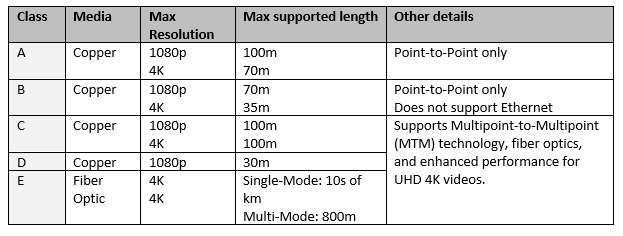What is HD Base-T and When Would You Use It?

HD Base-T is a worldwide connectivity standard that enables a single cable to carry multiple signals and power simultaneously. The cornerstone of HDBaseT technology is 5Play™, a feature set that converges uncompressed full HD digital video, audio, 100BaseT Ethernet, power over cable and various control signals through a single LAN cable.
HD Base-T is designed to solve the issue of cable clutter by reducing the number of connections to a single Category cable. It also transmits signals effectively over much longer distances than HDMI or DVI cables- up to 100m (328ft).
Meeting Modern Audio Visual Demands
Larger displays are increasingly common for classrooms, hospitals, hotels, and other enterprises. For image clarity at these scales, UHD video with 4K resolution is required. As the definition increases, more and more bandwidth is needed and transmission speeds are increasing relentlessly.
HDMI and DVI cables are commonplace for high definition data, but their use is only suitable for short distances. They are heavy and difficult to pull through conduits, and attenuation limits their use to less than 10m. In addition, high quality cables can be very expensive.
Preterminated multi-conductor and multi-format cables are another solution, but they are rigid and difficult to pull. Typically made on demand, they are expensive and lead times can be long.
However, HD Base-T is not intended as a replacement for HDMI or DVI. HD Base-T is ideal for extended distances, while HDMI ideal for the short distance signal interface.
HD Base-T and Other Signals
HD Base-T is a highly versatile standard. It supports all the key features and benefits of USB 2.0 and enables a number of control signals, including RS 232, Infrared (IR) and Customer Electronic Controls (CECs). It supports TV and PC video formats including enhanced, high-definition, ultra-HD (4K) and 3D video.
HD Base-T is different from Ethernet, but the two technologies can converge on the same types of media, and most classes of HD Base-T support Ethernet.
HD Base-T Classes
Choosing the right HD Base-T cable is a matter of identifying the network requirements. There are 5 Classes, which vary in terms of features such as transmission distance, resolution, and cost.

Cabling Requirements for HD Base-T
HD Base-T AV signals are a little more sensitive than the standard data signals carried on 10G Base-T. The signals are stronger and more complex, so the risk of alien crosstalk is higher.
HD Base-T was designed for ANSI/TIA compliant balanced twisted pair structured cabling systems, and ANSI/TIA 568 apply.
While Cat 5e or above can be used, Molex Connected Enterprise Solutions recommends a Category 6A solution to support HD Base-T. Cat 6A supports 10G Base-T, PoE and UPoE applications, supports longer distances, and has better immunity against crosstalk at higher frequencies. Cat 6A is a future-ready and cost-effective solution for HD Base-T installations.
In summary
HD Base-T is a robust, flexible protocol with proven technology. A true Plug & Play solution, it is easier to install than other cable types and is compatible with both Copper and Fiber Optic cables. With its ability to support 5PlayTM, Ethernet and the latest AV technology, it is an ideal solution for a number of high-bandwidth applications including broadcasting, collaborating and both local or remote cooperation.
Related Links
More technical bulletins on the Customer Support Portal (registration required)
